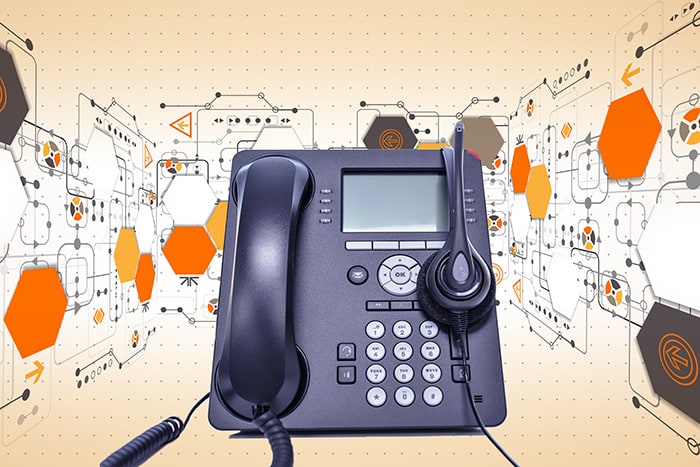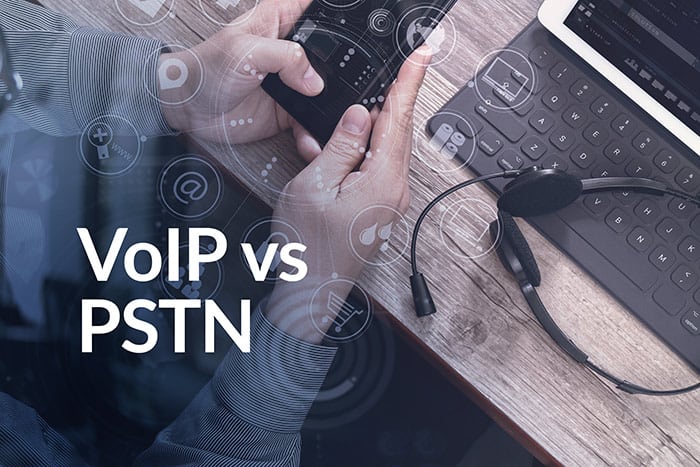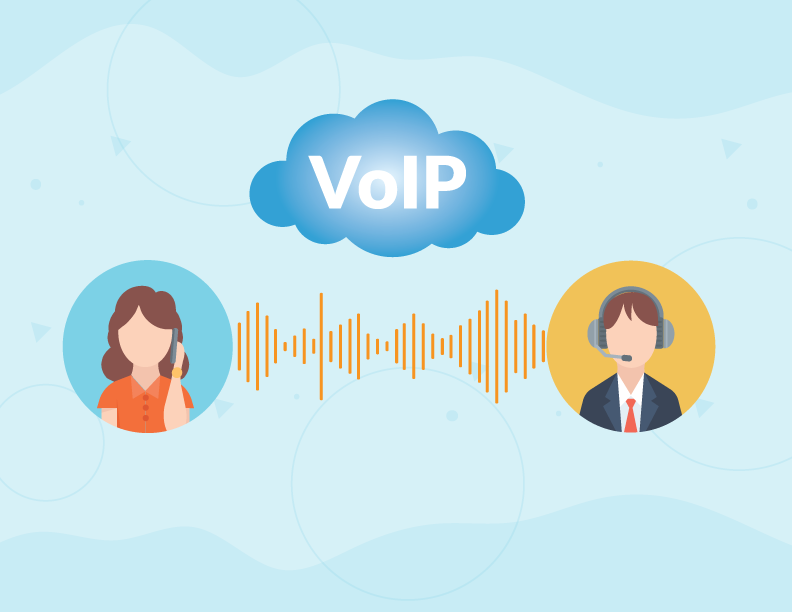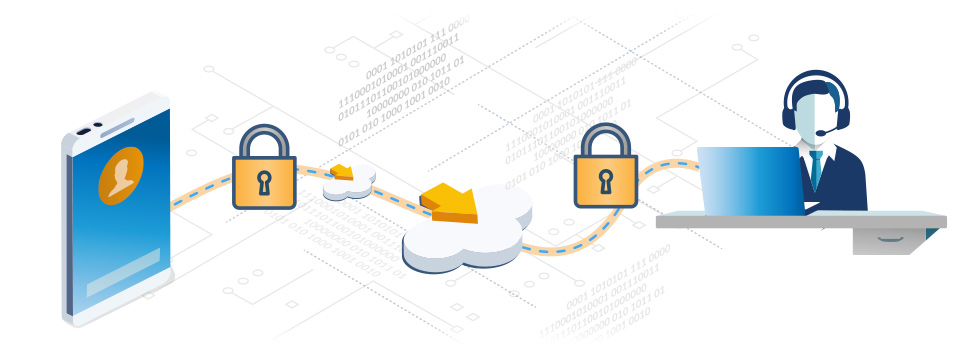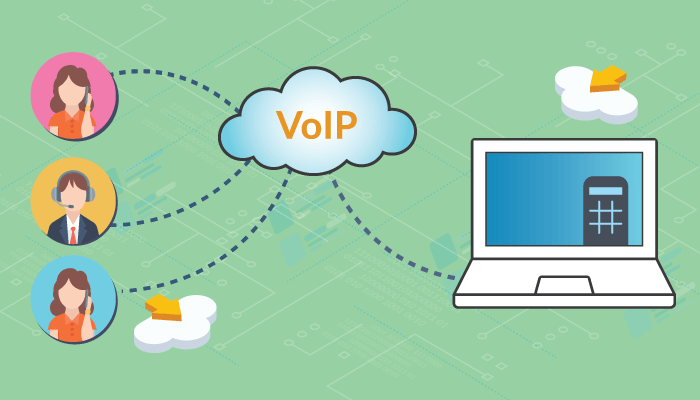VoIP integrations enable businesses to enhance their phone system. These types of voice over IP integrations help teams offer a better customer experience and improve workplace productivity.
In this article, we’ll look at:
- What is a VoIP Integration
- Benefits
- Features
- Types
What Is a VoIP Integration?
Voice over IP enables users to make and receive business calls from any location and through any device. This means your team can make calls from their computer or laptop while in the office or working remotely. All that is required is a stable internet connection. VoIP stores and transmits data securely in the cloud making it easy, safe, and convenient to use.
But the best part about VoIP is that it integrates comfortably with cloud-based applications and software. This is a great advantage over plain old telephone service. VoIP integrations let users switch between tools to store, share, and sync data between them. Doing so can cut down on time spent doing mundane, manual processes while keeping all your important data easily available.
16 Benefits of VoIP Integrations for Business
Any company that works with a VoIP integration or UCaaS will tell you that there are countless benefits of integration with their business phone system. Some top benefits of VoIP integrations include:
- Allowing users added versatility to multitask efficiently.
- Enabling call center agents to collaborate and share data and files.
- Seamlessly connect computers and telephones.
- Streamlining communications by unifying essential tools.
- Allowing users to stay connected from any device and any location.
- The ability to scale as needed.
- Having one centralized, unified platform for all essential business tools.
- Supporting remote working for distributed teams.
- The ability to receive live visibility and updates of call center activity.
- The ability to support a call center-type business.
- Easy set-up and management.
- The ability to innovate, customize, and adjust as your business needs evolve.
- Reducing monthly communication-related bills.
- Gaining access to local, national, and international numbers to boost global expansion and reach.
- Increasing office productivity and efficiency by streamlining workflows.
- The possibility of adding as many VoIP integrations as desired.
Key Features of VoIP Integrations
Now, what you can do with these integrations depends on your VoIP provider and what they offer. Some will offer a comprehensive set of calling features and analytics while others only offer a few select essential functionality. Here are some of the most common VoIP features to expect with your integrations:
1. Voice Calling
VoIP integrations let users make and receive calls through the internet. And when paired with a local, toll-free, or international number, your team can comfortably make local and international calls at relatively low rates. Plus, you benefit from VoIP features such as outbound calling, international call forwarding, and more.
2. Cloud Storage
VoIP providers offer cloud storage to help you securely store data for long periods. However, storage capacity and duration vary. Yet, this can help your phone system store and back up files, data, or call recordings on the cloud where they remain easily accessible.
3. Click-to-Call
Click-to-call generally works with most web browsers or software. This tool lets your team quickly call any number they find online or through their application. When they click the number, the call is placed through their VoIP device or softphone.
4. Contact Lists
This feature synchronizes your contacts across different platforms. This keeps customer information up-to-date and relevant, no matter where your teams access them. If contacts are not up-to-date or easily accessible, you can expect errors. So, such a feature leads to faster and more accurate customer service.
5. Voicemail, SMS, Fax
A voicemail transcription or voicemail-to-email feature sends voicemail messages and transcripts to users’ emails. You can then access these messages from anywhere. You can do the same with SMS and faxes. This way, you have documentation of voicemails, messages, and faxes securely stored.
6. Screen Pops
When calls come in, a ‘pop-up’ that displays customer information will turn up on the relevant agent’s screen. This provides the necessary context for the call, prepping the agent to respond optimally.
7. Call Recording
This feature lets you record incoming and outgoing calls and store recordings for future reference. You can use these recordings for training, documentation, analyzing trends, and more.
8. Data Sync & Call Reports
One of the most common features of VoIP integrations is the ability to automatically sync call and caller data. And most providers will offer that along with detailed call reports and analytics to help you understand your business’ call traffic.
8 Types of VoIP Integrations
There are a variety of VoIP integrations that can work well with your business phone system. However, which VoIP integration will boost your office’s productivity depends on what you are trying to achieve. Here are 8 types of integrations to consider:
1. Customer Relationship Management (CRM)
CRMs are mostly used to track customer contacts and their history with the company, track calls, SMS, faxes, emails, and so on. However, most CRMs available still depend on users manually and individually entering information.
A VoIP CRM integration can improve and streamline this process by automatically syncing communication-related details within your desired CRM.
This would increase efficiency by reducing the time spent entering this information accurately.
2. Helpdesk Software
Helpdesk software or customer support software serves as a central hub for managing and addressing customer inquiries and issues. It typically has features like ticket management, query escalation, multi-channel support, collaboration tools, etc.
Helpdesk integrations combine VoIP and customer support software to better equip your teams to provide quality and responsive customer support.
It helps you keep track of all customer interactions and communications in one place. At the same time, it offers users multiple channels and options to provide timely support.
3. Contact Center Software
This type of VoIP integration is designed to add call center and contact center capabilities to your business applications. With features like advanced call routing and call reporting, your teams can better handle incoming calls and increase efficiency.
For example, advanced routing and ACD can help route callers to the right destination within your organization. Similarly, the click-to-call feature will make it easy for your teams to place quick outbound calls.
These integrations bring call center functionality to your existing phone system.
4. PBX Integrations
You can also integrate VoIP into your existing PBX system. This gives you the ability to upgrade your legacy phone system by adding modern VoIP functionality to it. With VoIP and PBX working together, you can benefit from more global coverage, reliable call quality, secure voice network, and more.
5. Web and Video Conferencing
VoIP can also be integrated into web-based conferencing platforms. Think: Google Meet, Zoom, or even your in-house developed conferencing app.
This integration enables participants to join audio or video conferences through VoIP technology. It simplifies the process of hosting and attending virtual meetings and webinars. And it replaces the need for physical, traditional phone lines with more flexible communication technology.
6. Voice APIs
VoIP APIs are another common integration most providers offer. Application Programming Interfaces (APIs) allow developers to integrate and build systems that cater to specific business needs.
Your IT team can use voice or telephony APIs to integrate VoIP functionality into their custom applications or websites. This provides flexibility to create custom solutions tailored to your communication needs. And you can add key features such as click-to-call features, voicemail transcription, or call recording.
7. Mobile App Integration
More recently, you’ll find VoIP integrated into mobile apps. This allows users to make voice or video calls over the internet directly from the app. WhatsApp is a great example. These apps often use a data connection to transmit calls.
VoIP mobile integrations provide mobility and flexibility, enabling users to communicate using their smartphones and tablets from anywhere. Plus, you can quickly convert any app into one with communication-related capabilities.
8. Unified Communications (UC) Integration
UC VoIP integrations focus on adding multiple communication channels into one platform. Common channels include instant messaging, video conferencing, voicemail, fax, and email.
Some of these will have transcription abilities or send-to-email options. This way, users can switch seamlessly between these channels to communicate and collaborate. And they can quickly connect from any location or device. Your teams can increase productivity by centralizing communication tools, making it easier for teams to collaborate and share information.
Use VoIP to Empower Your Business
VoIP is an advanced communication service that can empower your employees by equipping them with the tools needed to perform efficiently. Think VoIP integrations can support your business needs? Speak with our experts to learn more today!



